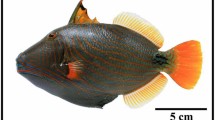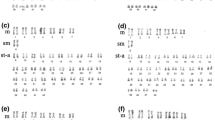Abstract
Because of its highly compact genome, the pufferfish has become an important animal model in genome research. Although the small chromosome size renders chromosome analysis difficult, we have established both classical and molecular cytogenetics in the freshwater pufferfish Tetraodon nigroviridis (TNI). The karyotype of T. nigroviridis consists of 2n = 42 biarmed chromosomes, in contrast to the known 2n = 44 chromosomes of the Japanese pufferfish Fugu rubripes (FRU). RBA banding can identify homologous chromosomes in both species. TNI 1 corresponds to two smaller FRU chromosomes, explaining the difference in chromosome number. TNI 2 is homologous to FRU 1. Fluorescence in-situ hybridization (FISH) allows one to map single-copy sequences, i.e. the Huntingtin gene, on chromosomes of the species of origin and also on chromosomes of the heterologous pufferfish species. Hybridization of total genomic DNA shows large blocks of (species-specific) repetitive sequences in the pericentromeric region of all TNI and FRU chromosomes. Hybridization with cloned human rDNA and classical silver staining reveal two large and actively transcribed rRNA gene clusters. Similar to the situation in mammals, the highly compact pufferfish genome is endowed with considerable amounts of localized repeat DNAs.
Similar content being viewed by others
References
Arai R (1983) Karyological and osteological approach to phylogenetic systematics of tetraodontiform fishes. Bull Natl Sci Mus Tokyo 9: 175–210.
Armes NJ, Gilley J, Fried M (1997) The comparative genomic structure and sequence of the Surfeit gene homologs in the puffer fish Fugu rubripes and their association with CpG-rich islands. Genome Res 7: 1138–1152.
Barat A, Khuda-Bukhsh AR (1984) Karyomorphology of a ‘sea frog’ Tetraodon fluviatilis (Tetraodontidae, Pisces). Curr Sci 53: 1108–1109.
Baxendale S, Abdulla S, Elgar G et al. (1995) Comparative sequence analysis of the human and pufferfish Huntington's disease genes. Nat Genet 10: 67–76.
Bernardi G (1989) The isochore organization of the human genome. Annu Rev Genet 23: 637–661.
Bloom SE, Goodpasture C (1976) An improved technique for selective silver staining of nucleolar organizer regions in human chromosomes. Hum Genet 34: 199–206.
Bradford CS, Miller AE, Toumadje A, Nishiyama K, Shirahata S, Barnes DW (1997) Characterization of cell cultures derived from Fugu, the Japanese pufferfish. Mol Mar Biol Biotech 6: 279–288.
Brenner S, Elgar G, Sandford R, Macrae A, Venkatesh B, Aparicio S (1993) Characterization of the pufferfish (Fugu) genome as a compact model vertebrate genome. Nature 366: 265–268.
Brunner B, Todt T, Lenzner S, Stout K, Schulz U, Ropers H-H, Kalscheuer V (1999) Genomic structure and comparative analysis of nine Fugu genes: conservation of synteny with human chromosome Xp22.2-p22.1. Genome Res 9: 437–448.
Collodi P, Barnes DW (1990) Mitogenic activity from trout embryos. Proc Natl Acad Sci USA 87: 3498–3502.
Crnogorac-Jurcevic T, Brown JR, Lehrach H, Schalkwyk LC (1997) Tetraodon fluviatilis, a new puffer fish model for genome studies. Genomics 41: 177–184.
Dutrillaux B, Laurent C, Couturier J, Lejeune J (1973) Staining of human chromosomes with acridine orange after treatment with 5-bromodeoxyuridine. CR Acad Sci (D) 276: 3179–3181.
Edwards YJ, Elgar G, Clark MS, Bishop MJ (1998) The identification and characterization of microsatellites in the compact genome of the Japanese pufferfish, Fugu rubripes: perspectives in functional and comparative genomic analyses. J Mol Biol 278: 843–854.
Elgar G, Sandford R, Aparicio S, Macrae A, Venkatesh B, Brenner S (1996) Small is beautiful: comparative genomics with the pufferfish (Fugu rubripes). Trends Genet 12: 145–150.
Fernandes-Matioli FMC, Almeida-Toledo LF, Toledo-Filho SA (1997) Extensive nucleolus organizer region polymorphism in Gymnotus carapo (Gymnotoidei, Gymnotidae). Cytogenet Cell Genet 78: 236–239.
Foresti F, Almeida-Toledo LF, Toledo-Filho SA (1981) Polymorphic nature of nucleolus organizer regions in fishes. Cytogenet Cell Genet 31: 137–144.
Gilley J, Fried M (1999) Extensive gene order differences within regions of conserved synteny between the Fugu and human genomes: implications for chromosomal evolution and cloning of disease genes. Hum Mol Gen 8: 1313–1320.
Gilley J, Armes N, Fried M (1997) Fugu genome is not a good mammalian model. Nature 385: 305–306.
Gourse RL, Gerbi SA (1980) Fine structure of ribosomal RNA. IV. Extraordinary evolutionary conservation in sequences that flank introns in rDNA. Nucleic Acids Res 8: 3623–3637.
Grady DL, Ratliff RL, Robinson DL, McCanlies EC, Meyne J, Moyzis RK (1992) Highly conserved repetitive DNA sequences are present at human centromeres. Proc Natl Acad Sci USA 89: 1695–1699.
Haaf T, Schmid M (1991) Chromosome topology in mammalian interphase nuclei. Exp Cell Res 192: 325–332.
Haaf T, Warburton PE, Willard HF (1992) Integration of human α-satellite DNA into simian chromosomes: centromere protein binding and disruption of normal chromosome segregation. Cell 70: 681–696.
Hellmer A, Voiculescu I, Schempp W (1991) Replication banding studies in two cyprinid fishes. Chromosoma 100: 524–531.
Hinegardner R (1968) Evolution of cellular DNA content in teleost fishes. Am Nat 102: 517–523.
Hinegardner R, Rosen R (1972) Cellular DNA content and the evolution of teleostean fishes. Am Nat 106: 621–644.
Holmquist GP (1992) Chromosome bands, their chromatin flavors and their functional features. Am J Hum Genet 51: 17–37.
How GF, Venkatesh B, Brenner S (1996) Conserved linkage between the puffer fish (Fugu rubripes) and human genes for platelet-derived growth factor receptor and macrophage colonystimulating factor receptor. Genome Res 6: 1185–1191.
Howell WM, Black DA (1980) Controlled silver-staining of nucleolus organizer regions with a protective colloidal developer: a 1-step method. Experientia 36: 1014–1015.
Jinxing W, Xiaofan Z (1993) Chromosome study of three tetraodontiform fishes. Zool Res 14: 345–346.
Khuda-Bukhsh AR, Barat A (1987) Chromosomes in fifteen species of Indian teleosts (Pisces). Caryologica 40: 131–144.
Miles C, Elgar G, Coles E, Kleinjan D-J, van Heyningen V, Hastie N (1998) Complete sequencing of the Fugu WAGR region from WT1 to PAX6: dramatic compaction and conservation of synteny with human chromosome 11p13. Proc Natl Acad Sci USA 95: 13068–13072.
Miyaki K, Tabeta O, Kayano H (1995) Karyotypes of six species of pufferfish genus Takifugu (Tetraodontidae, Tetraodontiformes). Fish Sci 61: 594–598.
Schempp W, Schmid M (1981) Chromosome banding in amphibia. VI. BrdU-replication patterns in Anura and demonstration of XX/XY sex chromosomes in Rana esculenta. Chromosoma 83: 697–710.
Schofield JP, Elgar G, Greystrong J et al. (1997) Regions of human chromosome 2 (2q32–q35) and mouse chromosome 1 show synteny with the pufferfish genome (Fugu rubripes). Genomics 45: 158–167.
Sylvester JE, Whiteman DA, Podolsky R, Poszgay JM, Respess J, Schmickel RD (1986) The human ribosomal RNA genes: structure and organization of the complete repeating unit. Hum Genet 73: 193–198.
Trower MK, Orton SM, Purvis IJ et al. (1996) Conservation of synteny between the genome of the pufferfish (Fugu rubripes) and the region on human chromosome 14 (14q24.3) associated with familial Alzheimer disease (AD3 locus). Proc Natl Acad Sci USA 93: 1366–1369.
Yeo GSH, Elgar G, Sandford R, Brenner S (1997) Cloning and sequencing of complement component C9 (1) and its linkage to DOC-2 in the pufferfish Fugu rubripes. Gene 200: 203–211.
Author information
Authors and Affiliations
Corresponding author
Rights and permissions
About this article
Cite this article
Grützner, F., Lütjens, G., Rovira, C. et al. Classical and Molecular Cytogenetics of the Pufferfish Tetraodon Nigroviridis. Chromosome Res 7, 655–662 (1999). https://doi.org/10.1023/A:1009292220760
Issue Date:
DOI: https://doi.org/10.1023/A:1009292220760




